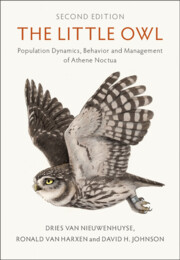Book contents
- The Little Owl
- The Little Owl
- Copyright page
- Contents
- Foreword
- Preface
- Acknowledgements
- Executive Summary
- Chapter 1 Introduction: Framework
- Chapter 2 History and Traditions
- Chapter 3 Fossil Evidence, Taxonomy and Genetics
- Chapter 4 Morphology and Body Characteristics
- Chapter 5 Distribution, Population Estimates and Trends
- Chapter 6 Habitat
- Chapter 7 Diet
- Chapter 8 Breeding Season
- Chapter 9 Behavior
- Chapter 10 Population Regulation
- Chapter 11 Management and Conservation
- Chapter 12 Research Priorities
- References
- Index
Chapter 1 - Introduction: Framework
Published online by Cambridge University Press: 29 September 2023
- The Little Owl
- The Little Owl
- Copyright page
- Contents
- Foreword
- Preface
- Acknowledgements
- Executive Summary
- Chapter 1 Introduction: Framework
- Chapter 2 History and Traditions
- Chapter 3 Fossil Evidence, Taxonomy and Genetics
- Chapter 4 Morphology and Body Characteristics
- Chapter 5 Distribution, Population Estimates and Trends
- Chapter 6 Habitat
- Chapter 7 Diet
- Chapter 8 Breeding Season
- Chapter 9 Behavior
- Chapter 10 Population Regulation
- Chapter 11 Management and Conservation
- Chapter 12 Research Priorities
- References
- Index
Summary
The framework of this book reflects the complexity of the situation of the species at different scales. To position the Little Owl in the cultural context we look at the history and cultural traditions connected to the species. We describe the taxonomy and subspecies to settle some taxonomic discussions of the species based upon major genetic, morphological and biogeographical findings. The distribution of the different subspecies and recent population estimates for the Western Palearctic are given to illustrate the geographic diversity. The habitat is described and its relationships with the species. Food as principle biotic factor delivers the crucial energy input for the birds. Abiotic factors such as breeding cavities and perches show their importance for breeding and foraging efficiency to minimize the energetic cost. Next we focus on the breeding season, discussing clutch size, hatching and fledging success in relation to the age of the birds. We then describe behavior mainly based upon two decades of webcam observations. Next we zoom in on limiting factors that influence populations in a given geographic environment, e.g., immigration, re-introduction or supplementation, and mechanisms of interaction between local populations, such as migration, meta-populations and sinks/sources. After describing the main causes for declines in the species, we summarize knowledge into a conservation and management strategy. We conclude this chapter with an overview of the key points raised, with an overview of the most important open questions and suggestions for future studies.
- Type
- Chapter
- Information
- The Little OwlPopulation Dynamics, Behavior and Management of <I>Athene noctua</I>, pp. 5 - 8Publisher: Cambridge University PressPrint publication year: 2023



